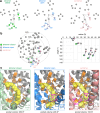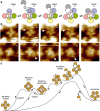Structural dynamics and permeability of the TRPV3 pentamer
- PMID: 40374654
- PMCID: PMC12081643
- DOI: 10.1038/s41467-025-59798-9
Structural dynamics and permeability of the TRPV3 pentamer
Abstract
TRPV3 belongs to the large superfamily of tetrameric transient receptor potential (TRP) ion channels. Recently, using high-speed atomic force microscopy (HS-AFM), we discovered a rare and transient pentameric state for TRPV3 that is in equilibrium with the tetrameric state, and, using cryo-EM, we solved a low-resolution structure of the TRPV3 pentamer, in which, however, many residues were unresolved. Here, we present a higher resolution and more complete structure of the pentamer, revealing a domain-swapped architecture, a collapsed vanilloid binding site, and a large pore. Molecular dynamics simulations and potential of mean force calculations of the pentamer establish high protein dynamics and permeability to large cations. Subunit interface analysis, together with thermal denaturation experiments, led us to propose a molecular mechanism of the tetramer-to-pentamer transition, backed experimentally by HS-AFM observations. Collectively, our data demonstrate that the TRPV3 pentamer is in a hyper-activated state with unique, highly permissive permeation properties.
© 2025. The Author(s).
Conflict of interest statement
Competing interests: The authors declare no competing interests.
Figures






References
-
- Cosens, D. J. & Manning, A. Abnormal electroretinogram from a Drosophila mutant. Nature224, 285–287 (1969). - PubMed
-
- Ferreira, L. G. B. & Faria, R. X. TRPing on the pore phenomenon: What do we know about transient receptor potential ion channel-related pore dilation up to now? J. Bioenerg. Biomembr.48, 1–12 (2016). - PubMed
-
- Zheng, J. & Ma, L. Structure and function of the thermoTRP channel pore. Curr. Top. Membr.74, 233–257 (2014). - PubMed
-
- Chung, M. K., Güler, A. D. & Caterina, M. J. TRPV1 shows dynamic ionic selectivity during agonist stimulation. Nat. Neurosci.11, 555–564 (2008). - PubMed
MeSH terms
Substances
Grants and funding
LinkOut - more resources
Full Text Sources
Miscellaneous

